The skin is the body's largest organ and has multiple functions. It acts as a barrier against the environment, is involved in the regulation of body temperature and provides an animal with a sense of touch. Oil glands in the skin secrete sebum that coats and protects the fur, helping to keep the skin moisturised and pliable. There are differences across breeds in the hair coats of cats and dogs and, of course, some breeds lack hair. Hair length or lack of hair will need to be considered when deciding on decontamination plans for pets with skin contamination. Many household products contain chemicals which can cause adverse effects on skin and some plants also pose a more serious risk.
Detergents
Detergents are very common household chemicals. They are found in a variety of cleaning products such as washing up liquids, toilet cleaners and fabric washing products and come in the form of liquids, powders and liquid capsules. The severity of the effects depends on the quantity, concentration, duration of contact and type of detergent involved. Non-ionic detergents are generally less irritating than anionic detergents (Gloxhuber, 1974). Toiletry products containing detergent such as shampoo and shower gel, will be less irritating than cleaning products that contain detergent, as they are intended for use directly on the skin. Cationic detergents, such as benzalkonium chloride and didecyldimethyl ammonium chloride, are found in household disinfectants and patio cleaners and are very irritant to tissues.
The main effects of exposure to detergents are gastrointestinal irritation, respiratory complications from aspiration of froth and foam, usually from vomiting, and skin irritation. Detergents are mildly alkaline and when in contact with the skin they can cause irritation with erythema, inflammation and dermatitis. In severe cases there can be burns, alopecia, which is more common in cats (Figure 1), oedema and skin sloughing. Severe signs are more likely to occur if the skin is not promptly and thoroughly decontaminated aft er detergent exposure.
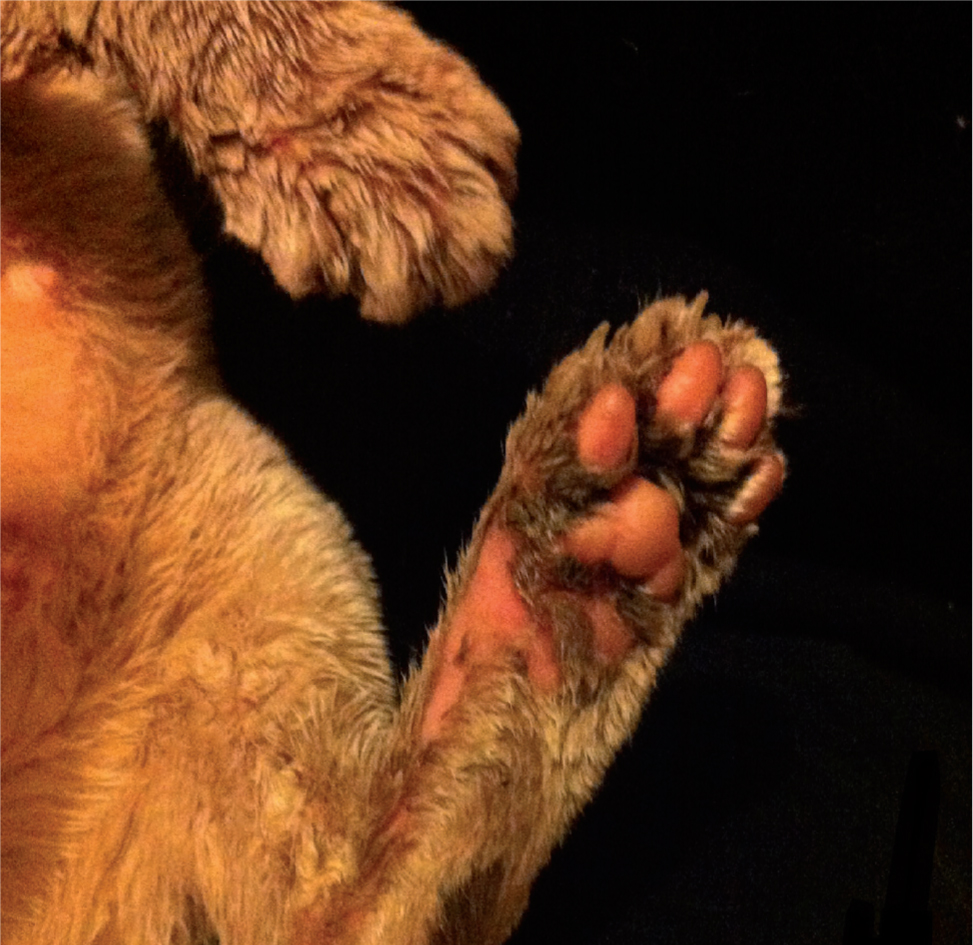
Corrosive substances
Corrosive substances can cause serious tissue damage and are characterised by the prolonged period during which the burning effect continues, aft er the initial injury. Strong alkalis such as sodium hydroxide (caustic soda) and potassium hydroxide (caustic potash) are commonly available as oven (Figure 2) and drain cleaners, although some can be purchased as the chemicals themselves, for use with household cleaning (Figure 2). Products containing corrosive chemicals carry a hazard warning label (Figure 3).
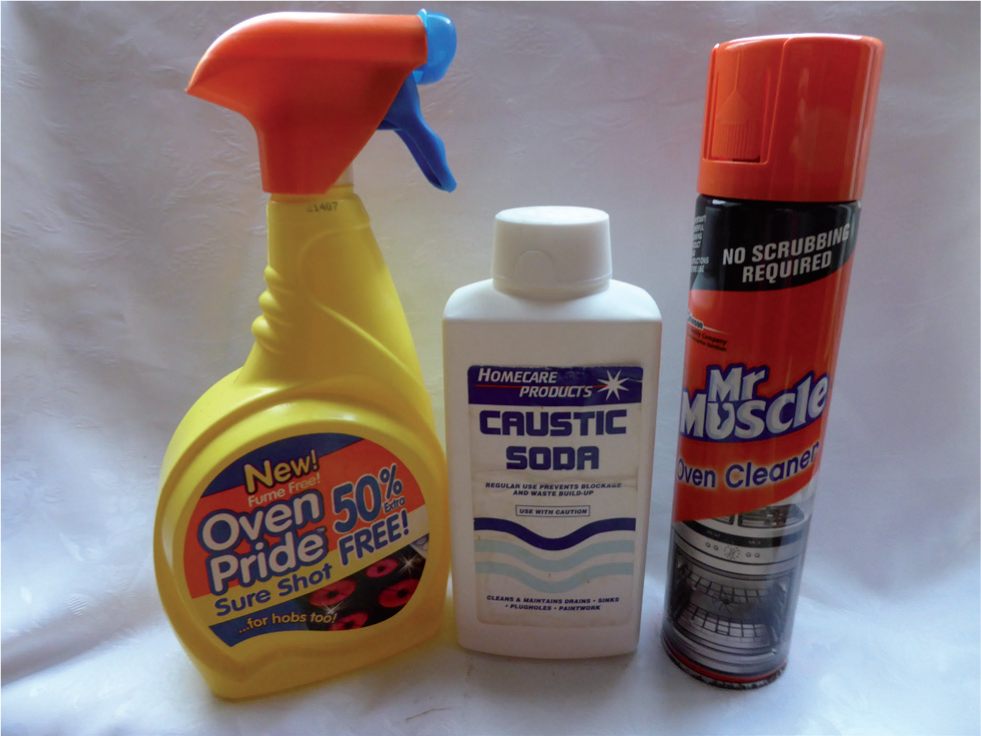
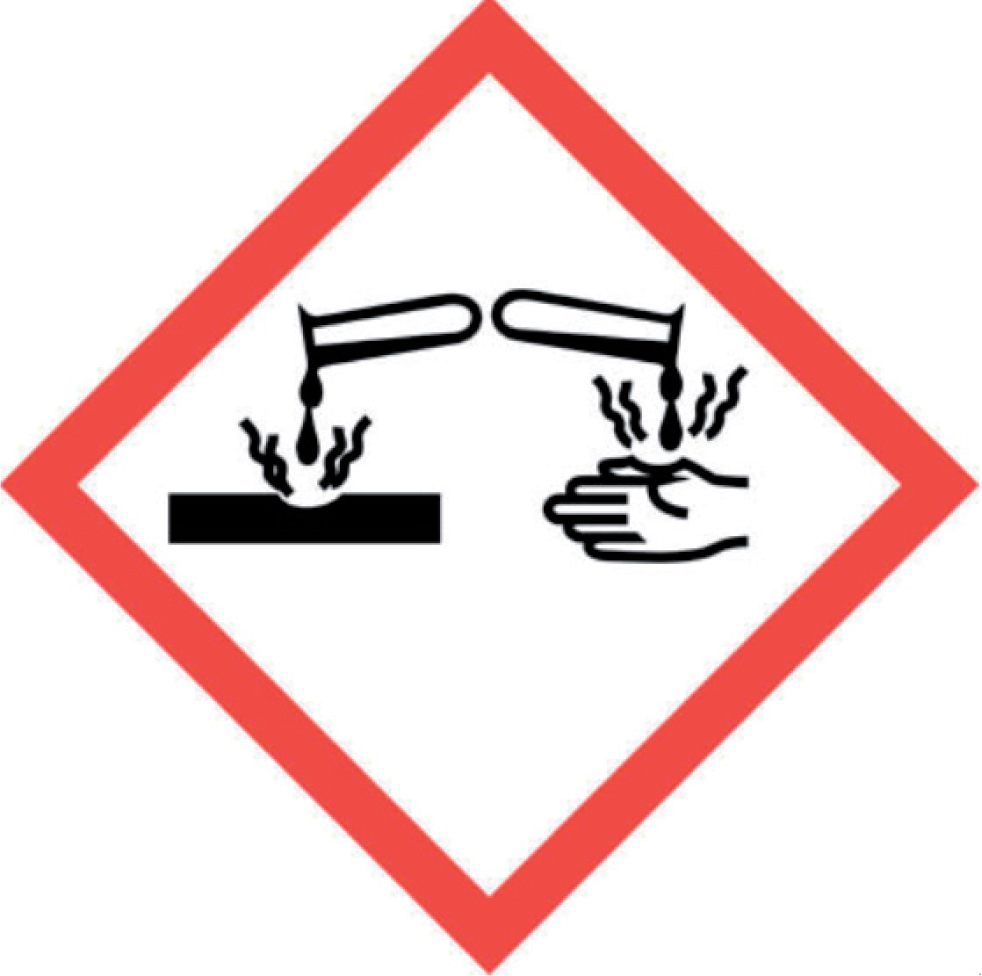
Alkalis cause liquefactive necrosis with saponification of fats and solubilisation of proteins; they also absorb water from tissue. These effects result in adherence to and deep penetration into the tissues. In contrast, acids cause coagulative necrosis, which can reduce further penetration of the acid into the skin, protecting deeper tissues, although in severe cases deep tissue burns may occur. Exposing the skin to strong acids such as hydrochloric acid, nitric acid and sulphuric acid would cause more severe injuries than weak acids, such as citric acid and lactic acid. Hydrochloric acid may be present in some toilet cleaners (Figure 4) and sulphuric acid is present in battery acid. Citric acid and lactic acid may be found in kettle descalers.
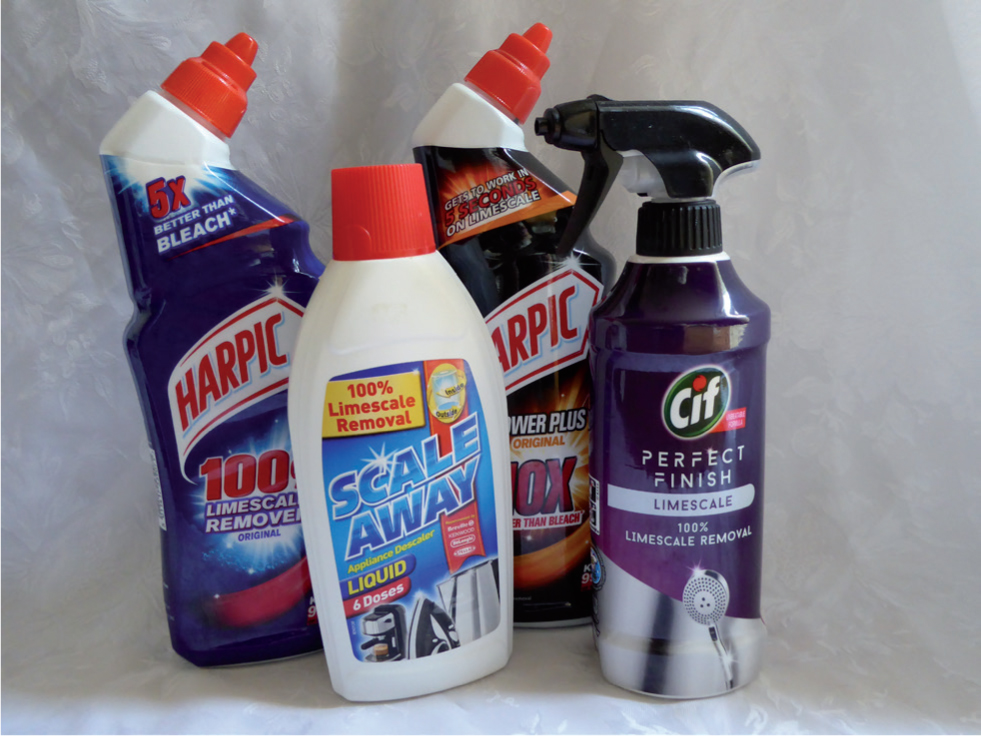
Skin irritation, ulceration and burns have been reported in pets exposed to oven cleaners. Oven cleaners are a particular risk as the cleaner is usually left to soak into the burnt-on food material and pets may lick or walk through spills and drips (Bates and Edwards, 2016).
Cement, which typically contains alkaline calcium oxide or silicate, is also strongly alkaline. In a review of 42 dogs exposed to cement, most symptomatic animals were reported to have vomiting, but some dogs also had ocular and oral burns. In one case, a Labrador had clawed and chewed at bags of cement and was found coughing 45 minutes later. Handfuls of cement paste were removed from the dog's mouth. Ocular irrigation and oral lavage were performed and the dog was repeatedly washed until the skin pH was neutral, which took 2 hours. There was also oral inflammation with sloughing of the buccal mucosa and loss of tongue epithelium (Blackett and Bates, 2020). Although this dog survived, it may have had more serious or even fatal consequences without prompt treatment.
Petroleum distillates
Petroleum distillates are also found in numerous household products, such as white spirit (turpentine substitute), oil lubricants for hair clippers, paraffin, petrol and barbecue lighter fuels. They are irritant to the skin and mucous membranes, including the gastrointestinal tract. On the skin they dry and remove fat from the affected area, leading to irritation and erythema. Petroleum distillates are thought to cause effects on mucous membranes and skin by dissolving lipid membranes and damaging cells (Rauber-Lüthy and Kupferschmidt, 2010). In addition, there may be dermatitis, blisters, inflammation, alopecia and prolonged contact can result in burns.
Asphalt and Tarmac
In the UK the term asphalt is used to refer to a mixture of mineral aggregate and bitumen. The addition of tar to macadam (crushed rock) roads led to the word Tarmac, which is the word most commonly used to refer to road-making materials. However, since the 1970s, asphalt (bitumen) has completely overtaken the use of tar for road making.
Cats and dogs may be exposed to asphalt when they walk over newly asphalted roads and it can stick to paws and hair. In cases reported to the Veterinary Poisons Information Service (VPIS) cats and dogs have developed erythema, hypersalivation, vomiting, pyrexia, lethargy and diarrhoea after exposure to asphalt. Occasionally paw oedema and tongue ulceration may occur and if the asphalt is still hot, it may cause local burns. There is also the potential for self-trauma if the pet chews at their feet or skin in an attempt to remove the asphalt, according to VPIS case data.
Decontamination of skin
Precautions
Any animal that is exhibiting signs of cardiovascular collapse, respiratory distress or profound neurological depression should be stabilised before decontamination is attempted. If dermal decontamination is to be delayed, placing a collar or cone should be considered to prevent grooming and ingestion.
It is important to ensure staff are adequately protected, by using aprons, gloves and goggles (Bough, 2003) when decontaminating animals. Goggles should be used for decontamination of an animal exposed to a substance that can cause injury to the eyes if splashed. For some substances, such as strong-smelling solvents or respiratory irritants, a mask may be needed. The type of mask will depend on the form of substance involved, for example a gas or particulate matter or dust. It will also be necessary to ensure the area is well ventilated. Remember that anything used to transport the animal (such as basket or blanket) may also be contaminated.
Care should also be taken to prevent pets ingesting substances used in dermal decontamination, such as soap and the run-off water containing the contaminant.
It should be noted that emesis following accidental ingestion of a detergent, petroleum distillate or corrosive substance is contraindicated and activated charcoal is not useful. It is therefore important to ensure prompt and thorough dermal decontamination, to prevent ingestion by grooming.
Bathing
Bathing is generally the best technique for removing substances from the fur and skin. A dermal decontamination plan will need to take into account the substance involved, its concentration, the extent of contamination, the duration of exposure and the clinical condition, species, breed and disposition of the companion animal involved. Sedation may be required to allow dermal decontamination, but care should be taken in animals with respiratory signs following aspiration, since sedation may suppress the cough reflex and affect the clearance of the aspirated material from the lungs.
In most cases of dermal exposure, warm water and a mild detergent (such as washing up liquid) are suitable for decontamination of the skin and fur. Machine dishwasher detergents should not be used as they are too irritating and pet shampoos may be ineffective, as they are too mild. If the chemical is strong smelling, the absence of its odour may be used as a guide to determine the effectiveness of decontamination.
In small patients it is important not to induce hypothermia with the use of cold water. Once decontamination is complete the animal should be towel-dried and kept warm. If the substance is a dry powder, decontamination should start with brushing the coat before washing, taking appropriate precautions for potential dust inhalation.
If the contaminant has been splashed on the coat, it is also important to examine the eyes, inside the ears and between the toes to identify the affected areas and to ensure thorough decontamination. If the irritant or corrosive material is spilled on the head or neck, care should be taken to ensure that the run-off water does not contaminate the eyes during washing.
Oily and greasy material
Contamination with oily or greasy substances which are not very water soluble, such as spot on treatments, engine oil or essential oils, may require stronger degreasing detergents such as Swarfega (in the UK) or Goop (in the USA). Some degreasers contain beads or other insoluble substances to aid cleansing and removal of dirt and grease, but products without these additions are most suitable for the decontamination of animals. It is important to note these degreasers are more effective if applied to dry fur, as they may be water-soluble themselves. After application to the affected area, the degreaser should then be thoroughly washed off.
Sticky material
Sticky material, such as glue traps, fly paper or asphalt, can be softened with vegetable oil, margarine or butter (Bough, 2003). This can also help with oily or greasy material. After decontamination, these substances can then be washed off, although ingestion of a small quantity is not hazardous. Solvents, such as alcohol or light petroleum products such as white spirit, are not recommended for dermal decontamination because they can spread the contaminant further and may also irritate the skin.
If there is heavy contamination, or there are large clumps of material adhering to the fur, it may be more practical to clip contaminated hair, particularly in long-haired animals.
Safe to leave on skin or fur
Some substances, such as superglue or non-water-based paint, may not be easily removed with dermal decontamination. However, once dry these substances pose a low risk for poisoning and can be left on the skin or hair and allowed to wear off naturally. This would have to be carefully assessed though, as the pet may repeatedly attempt to groom the affected area and this could lead to self-trauma. In this case, any lumps can be clipped off or a collar or cone can be placed.
Corrosive substances
The mainstay of management of chemical burns, particularly from corrosive chemicals, is to minimise the time when the chemical is in contact with skin. This requires thorough, prompt and often prolonged irrigation.
Water irrigation has long been recommended for the initial management of corrosive burns. It has multiple effects including dilution of the chemical, removing it from tissues, reversing the hygroscopic (water absorbing) effect of chemicals and restoring normal skin pH (Bromberg et al, 1965).
Acids and alkalis on the skin should never be neutralised, as this reaction generates heat, which can cause further tissue damage. Dermal exposure to strong alkalis (such as sodium hydroxide or potassium hydroxide) requires very thorough decontamination, as these chemicals can cause deep, penetrating burns that can be painless initially, but will continue to progress over a few hours. Rinsing the contaminated area will only remove surface alkali, therefore repeated irrigation is required. After the initial decontamination, once the pH of the skin appears to be neutral (check with litmus paper or a urine dipstick), wait for 15 minutes. This allows residual alkali to diffuse up from the deeper regions of the dermis (Herbert and Lawrence, 1989; O'Donoghue et al, 1996). If the area remains strongly alkaline on a repeated check, irrigation should be repeated. In some cases, this can take several hours of repeated periods of decontamination, as outlined in the aforementioned case of the dog exposed to cement.
Management of dermal injury
Following thorough decontamination, any signs of irritation should be managed conventionally. Mild irritation from petroleum distillates will usually respond to an emollient, but a topical steroid may be required for moderate to severe dermatitis. Severe irritation from detergents, corrosives or petroleum distillates should be managed the same as a thermal burn injury. Analgesia may be required and animals with oral injury that results in inappetence or anorexia should be fed soft, moist food with a syringe or by tube feeding in severe cases.
Photodermatitis
Many plants can cause dermal reactions, particularly with repeated exposure but some produce effects from contact in combination with sunlight. This occurs with hogweed.
Heracleum mantegazzianum (giant hogweed, Figure 5) is a very tall plant found throughout Britain and Ireland, especially beside water. This species arrived in Britain in the 19th century and is now controlled by law, making it an offence to plant it. The native Heracleum sphondylium (cow parsnip, hogweed, keck) is a smaller plant but it also found in grassy places, hedgerows, open woods and watersides throughout Britain and Ireland. These plants contain psoralens which sensitise the skin to sunlight (they are phytophototoxins). Skin reactions occur from contact with the plant in combination with exposure to long-wave ultraviolet light, that is, sunlight (Klaber, 1942). Skin damage can result from any activity that involves touching the psoralen-containing plants, in combination with exposure to ultraviolet light. Phototoxic effects are the result of ultraviolet light-induced binding of psoralens into nuclear deoxyribonucleic acid, resulting in cross-links and subsequent cell death. This causes skin damage (phytophototoxicity), which may be severe (Song and Tapley, 1979). Even close contact with animals which have been in contact with hogweed may result in dermatitis in humans (Camm et al, 1976), so care must be taken when handling animals exposed to hogweed.
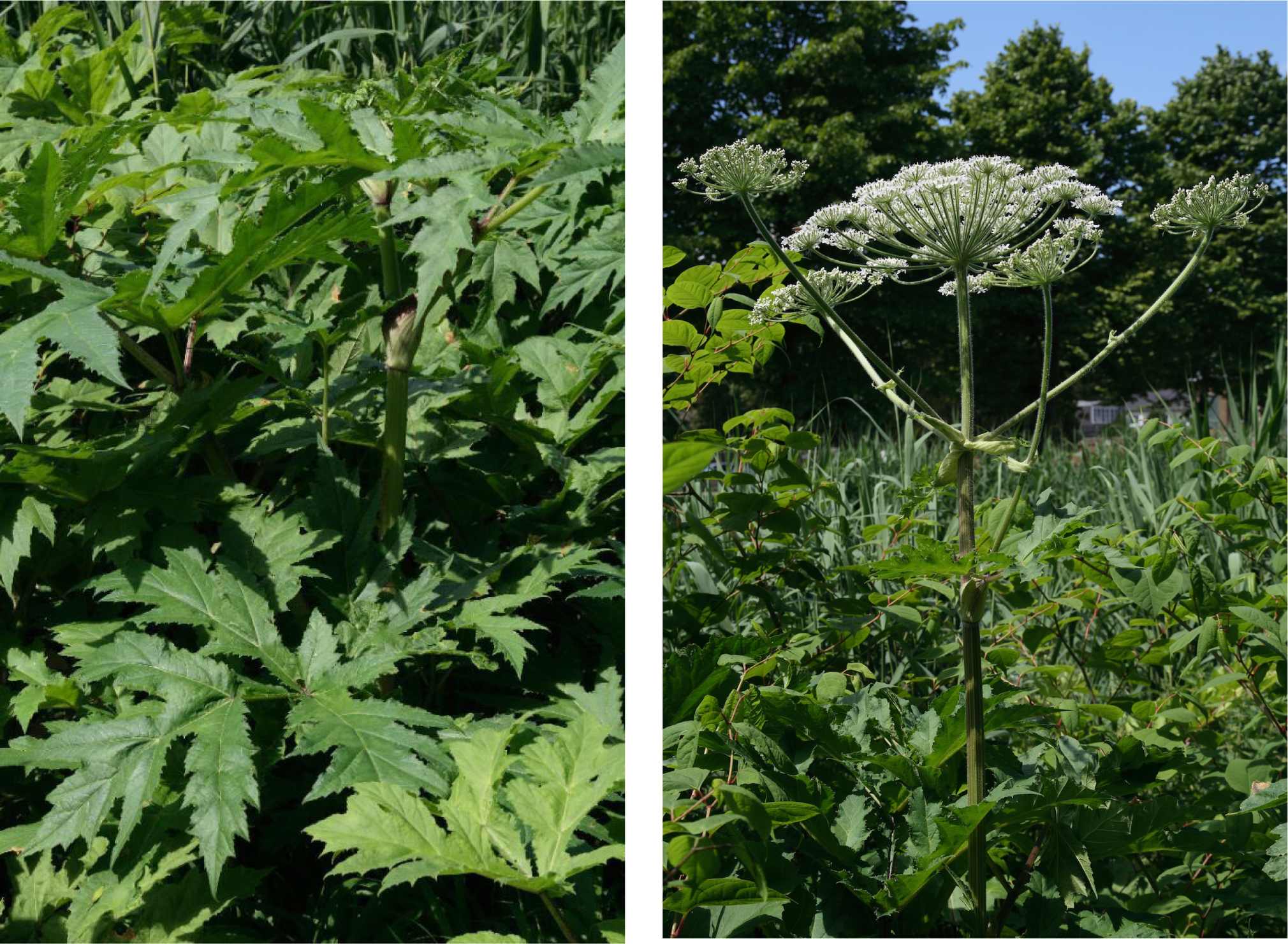
Dermal effects from contact with hogweed have been reported in dogs (Hintermann, 1967; Dolowy, 1996; Pötz, 2015), o˛ en when they have been playing and run into a stand of hogweed plants. The fur may provide some protection and effects can be more pronounced on areas with less hair cover.
Inappetence, hypersalivating, vomiting, diarrhoea and ulceration around the mouth have been reported from ingestion of hogweed in animals. However, most cases involve dermal exposure and this can result in severe erythema, alopecia, oedema, scaling, blistering, ulceration and dermatitis. Dermal signs can progress over 24–48 hours and recovery can take weeks; there is also the risk of secondary infection of affected areas.
If exposure was recent, the area should be washed thoroughly with soap and water as soon as possible. It is important to keep the animal out of sunlight for at least 48 hours post-exposure, even if they are asymptomatic. If dermal signs develop, management should be tailored to symptoms as they occur. Analgesia can be administered for pain, antihistamines can be used to treat erythema or blisters, systemic or topical steroids may also help to relieve irritation (Pötz, 2015; Baker et al, 2017). Antibiotics may be required in cases of secondary infection of dermal lesions.
Conclusions
Many household products can cause dermal effects if the affected skin is not decontaminated promptly. In many cases bathing is suffcient, but some substances require the use of degreasers, oil or fat to soften them and allow their removal. In animals with dermal contamination, it is important to determine the substance involved if possible, in order to take appropriate precautions and determine a suitable decontamination plan, which should consider the method and duration of decontamination required. Management thereafter should be supportive, based on the symptoms.
KEY POINTS
- Many household chemicals and products can cause dermal injury, particularly if they are left on the skin for a prolonged period.
- Detergents, petroleum distillates and corrosive chemicals (strong acids and strong alkalis) are commonly involved in dermal contamination.
- Bathing is suitable in most cases but the use of degreasers, oil or fat may be needed for oily or sticky materials.
- Depending on the substance involved, protective clothing and a well-ventilated area may be needed for decontamination.
- Management of skin irritation or burns should be supportive.
- Photodermatitis is also a risk for pets, when exposed to psoralen-containing plants (such as hogweed) and sunlight.

